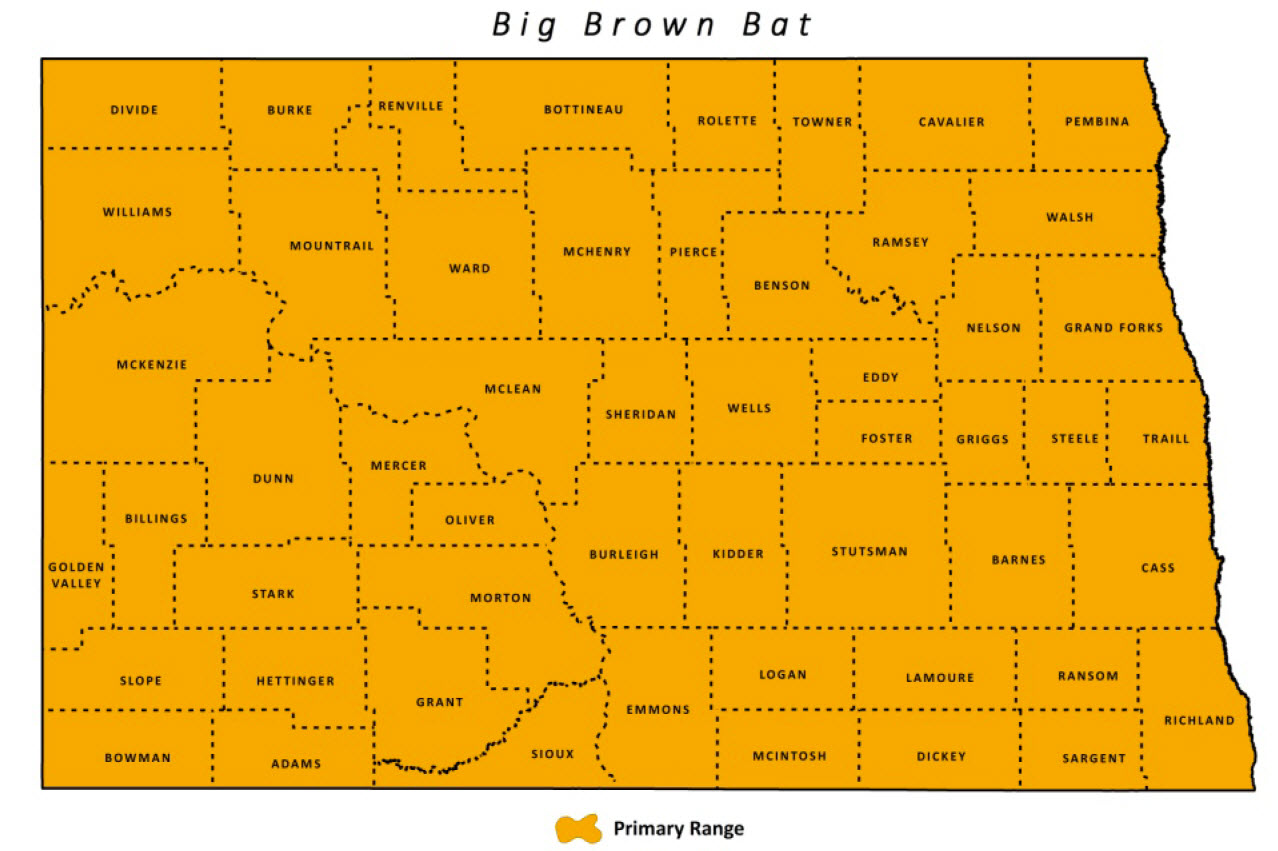
Big Brown Bat
| Scientific Name | Eptesicus fuscus |
|---|---|
| General Description | Resembles the Little Brown Bat but for its larger size. An adult bat can reach 20 grams. Fur is dark brown in color, tragus and uropatigium lack hair. |
| Status | Year-round. One of two species documented as hibernating in North Dakota. |
| Abundance | Common |
| Primary Habitat | Found in both urban and rural habitats. Insect availability tends to be the limiting factor versus a type of habitat. Commonly associated with trees. |
| Federal Status | None |
| Reason for Designation | Although common in North Dakota species is threatened by a fungal disease known as white-nose syndrome in the eastern and Midwest portions of its range. |
Locations and Conditions of Key Habitat
Preferred Habitat
Species does not require a specific habitat. If water and food (hard bodied insects) are available Big Brown Bats can be found. Will use buildings, bridges, and dead trees as roosting habitat.
Key Areas and Conditions for Big Brown Bat in North Dakota
Big Brown Bats are found throughout the state.
Problems Which May Affect this Species
Habitat
Loss and disturbance of roost habitat is a threat to this species.
Other Natural or Manmade Factors
White-nose Syndrome is a significant threat to this species. North Dakota bat species are insectivores. The use of pesticides in the vicinity of a feeding ground would affect bat populations by killing prey. This species is known to store pesticides within fat reserves. Accumulation within body may cause negative reactions or death. Wind turbines have been identified as a source of mortality to bats and several turbine “farms” are under construction in parts of North Dakota. Indiscriminate killing due to a negative public perception has been identified as a possible threat to this species.
Research and Survey Efforts
Current Research or Surveys
- North Dakota State University is currently trying to identify potential roosting and hibernacula habitat in western North Dakota.
- North Dakota State University is currently developing a Bat Management/White-nose Syndrome Response plan.
Previous Research or Surveys
- A survey of bat species in the state was conducted by North Dakota State University (SWG T2-5-R).
- Northern Prairie Wildlife Research Center identified previous work for mammals in North Dakota.
- A number of agencies have surveyed for small mammals in the southwestern part of the state, including REAP, Theodore Roosevelt National Park, the U.S. Forest Service, and U.S. Bureau of Land Management.
Additional Research or Surveys Needed
- Implement a protocol to monitor bats within the state on a long-term basis.
- Research to address primary threats to this species.
Management Recommendations
- Protection and restoration of riparian habitat.
- Manage riparian habitats to maintain snags, connecting corridors, and edges.
- Maintain and improve seeps, ponds, and other wet areas as water sources.
- Education on the benefits and misconceptions about bats.
- Determine and protect nursery and hibernation sites.
- Provide roosting sites in areas where natural sites have been destroyed or disturbed.
- Reduce use of pesticides near waterways where bats forage.
- Protect roosting habitat by easement or land acquisition where possible
Monitoring Plans
A monitoring protocol will be addressed in the Bat Management Plan currently under development.
2005-2015 Progress
The Big Brown Bat was added to the Species of Conservation Priority list during the revision of the Wildlife Action Plan in 2015.

Note: A listing of works consulted when compiling the information on this page may be found in the 2015 State Wildlife Action Plan.
